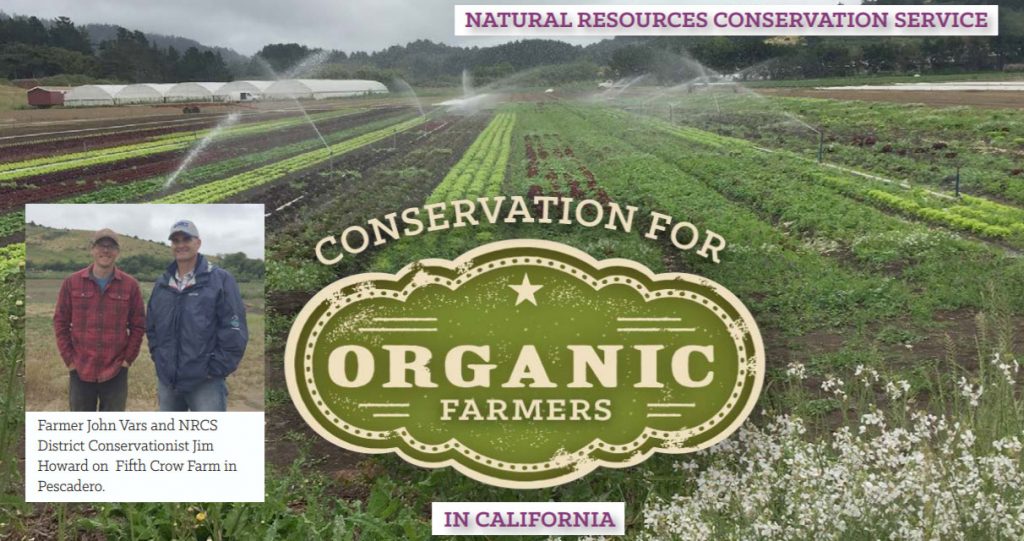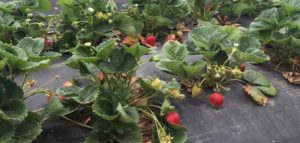 “When you first start farming, you have ideas of what you want to do to be sustainable and successful, but you can’t afford it,” says 39-year old John Vars of Fifth Crow Farm. “When you can afford it, you may find it hard to go backwards—like where you want a road you may have already put a hedgerow.” To help get their best ideas aligned with good agronomy, engineering and financial help, John and his farming partners, Teresa Kurtak and Mike Irving, called Jim Howard with USDA’s Natural Resources Conservation Service before they even put in their first crop in 2008.
“When you first start farming, you have ideas of what you want to do to be sustainable and successful, but you can’t afford it,” says 39-year old John Vars of Fifth Crow Farm. “When you can afford it, you may find it hard to go backwards—like where you want a road you may have already put a hedgerow.” To help get their best ideas aligned with good agronomy, engineering and financial help, John and his farming partners, Teresa Kurtak and Mike Irving, called Jim Howard with USDA’s Natural Resources Conservation Service before they even put in their first crop in 2008.
The three partners met when they were apprenticing at UC Santa Cruz’s Farm and Garden Program. They run a diversified organic orchard, vegetable and chicken farm a mile and a half from the Pacific Ocean in Pescadero, Calif.
The young farmers and NRCS’s Howard mapped out several strategic goals to tackle together: hedgerows to house pollinators and beneficial insects; cover crops, composting and crop rotation to revive the depleted soil; grassed waterways and underground outlets to help with erosion, drainage and water quality; and a hoop house to extend the growing season. But the biggest undertaking has been pumping, piping, storing and irrigating with water from nearby Butano Creek—a water resource they share with many other farmers as well as imperiled steelhead trout.

Howard and Vars checking out one of the farms numerous biodiverse hedgerows.
“All San Mateo County farmers have water security issues,’ says Howard. “There just isn’t enough for every farmer to do what they want.” In response, NRCS works on a two-phased approach to share water between farms and fish, he says. “We maximize irrigation efficiency, then, where possible, we develop off-stream water storage. This allows water to be taken from the creek strategically to reduce effects on fish while providing some water security for farmers.”
John shows off all the equipment—the pumps, tanks, pipelines, flow meter and variable frequency drives—which facilitate the micro irrigation and sprinkler systems that water Fifth Crow’s rainbow-colored greens and flowers. “The flow meter allows us to know exactly how much water is going onto the fields,” says John. “If it seems like too much I can troubleshoot for leaks or other problems. The storage tanks hold about 30,000 gallons of water, about one day’s supply. “We could use more..,” says John, wistfully.
“Working with NRCS has given us the confidence to take on projects that we wouldn’t have otherwise been willing to do,” he adds.
Fifth Crow Farm started with just ten acres. Now, eight years later, it has grown by 10 times its original size. “The first couple of years were a struggle,” says Teresa, “but little by little we have been successful and we have seen productivity go up.”
 The three farmers agree that one measure of their farm’s success can be gauged by smelling, feeling and laboratory testing the rich, dark, healthy soil that makes the farm’s productivity possible. Before 2008 the land had been farmed conventionally, tilled regularly and planted season after season to the same few crops. With NRCS’s help, Fifth Crow developed special cover crop mixes and rotation plans for more than 30 crops and flowers. As a result the organic matter in the farm’s soil has risen from one percent to between three and four percent in less than a decade
The three farmers agree that one measure of their farm’s success can be gauged by smelling, feeling and laboratory testing the rich, dark, healthy soil that makes the farm’s productivity possible. Before 2008 the land had been farmed conventionally, tilled regularly and planted season after season to the same few crops. With NRCS’s help, Fifth Crow developed special cover crop mixes and rotation plans for more than 30 crops and flowers. As a result the organic matter in the farm’s soil has risen from one percent to between three and four percent in less than a decade
The farm’s numerous hedgerows not only provide a windbreak and attractive dividing lines between fields, roads and riparian areas, they also add habitat for pollinators and beneficial insects. Howard rattles off a litany of Latin and common names as he points out species in the hedgerow: “Ceanothus, Ribes, Phacelia, Mimulus, Yarrow, Twinberry…the idea is to have something blooming at all times of year—to create sort of a sanctuary of habitat,” he says.
When asked what makes Fifth Crow a successful farm, John expands his answer beyond the vital soil, water, sun and plants. “Our farm is not one thing,” muses John. “It’s an ecosystem, not just of the natural world but one that includes people—the people who manage it, the people who work it, and the customers who support it. Stewardship takes all of us working together.”
To learn more about organics, visit the USDA organic website www.usda.gov/organic, or the NRCS organic website www.nrcs.usda.gov/organic
Image credit: Images courtesy of USDA/NRCS California.










